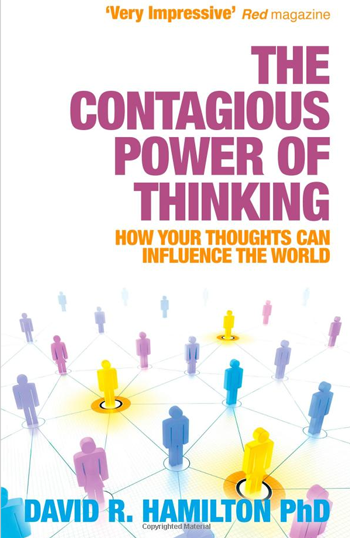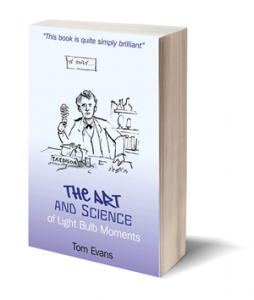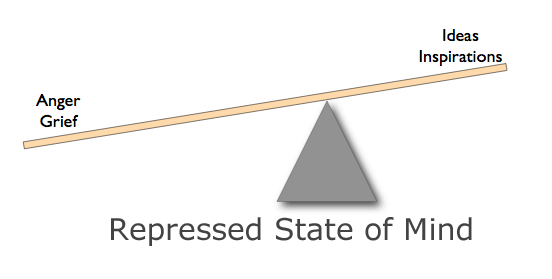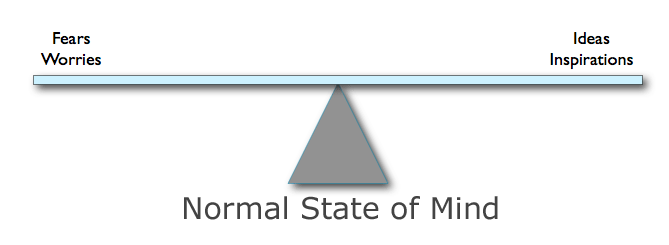by Tom Evans | Sep 26, 2011 | Illuminating
 I had the great pleasure last week of hearing Dr David Hamilton talking about the remarkable properties of mirror neurons in the brain. They are the mechanism behind how we empathise, emulate, copy and learn.
I had the great pleasure last week of hearing Dr David Hamilton talking about the remarkable properties of mirror neurons in the brain. They are the mechanism behind how we empathise, emulate, copy and learn.
This resulted in many light bulb moments firing in this particular head of mine.
I’ve been doing talks and workshops on creativity and innovation for some years now and I’d noticed that when I get into the state where I can receive light bulb moments, people in the room would follow shortly after.
To find out how this all works, I recommend you buy David’s book called The Contagious Power of Thinking or, better still, attend one of his talks and then buy the book – as he explains it all much better than I ever could.
So at my talks naturally people will pick up on my body language, the words I say and the images should I use any slides or handouts. The mirror neurons are the mechanism whereby such empathy is achieved. There is something which is more subtle in operation too however.
Before I even get to the venue to do the talk, I set my intention that the attendees of the talk will get into the state of having light bulb moments. Furthermore, that this state will linger either for a few days after the talk or even permanently.
People report having not known why they came to a particular talk but that they felt strangely drawn to attend. They also can’t remember where they first heard about it.
Now I am not claiming any extrasensory powers. What everyone is experiencing is a natural state of affairs and happens all the time but, mostly, outside our conscious awareness.
What is interesting is how this concept can be applied in business – especially if the business is involved in new product development or any creative field such as publishing, marketing, design or any artistic endeavour.
Any mindset we adopt will spread unconsciously – including anger, fear and guilt – and any behaviour and culture set will also ripple throughout an organisation like gossiping and lunchtime drinking.
So if you want innovation to spread in your organisation, it needs to be seeded and then it will spread organically. For example, apocryphally a US president visiting NASA in the Apollo era asked a janitor what he did and the reply was, “I fly rockets to the Moon”. This type of team spirit amplifies, reflects and ripples from mirror neurons to mirror neurons in each team member working to a common goal.
Sowing the seeds for innovation
The first step is to initiate the culture change with a thought and attitude and it can start anywhere in the organisation but ideally with senior management. The end goal is for it to be adopted from the bottom up whilst also aiming to remove the whole idea of the top and bottom hierarchy, as one could not exist without the other and it is in essence more like a symbiosis.
Then practical steps should be taken to foster innovation throughout the business, such as:
1. A simple suggestion box [perhaps anonymous]
2. A suggestions wall or whiteboard [best seeded with an associative Mind Map]
3. A more formal and facilitated intervention like a Walt Disney Three Rooms session or de Bono’s Six Thinking Hats. Even better again would be to use Appreciative Inquiry which additionally generates a positive thinking mind set. The idea of positive thinking also spreads like wildfire and is based on taking what works and making it even better rather than focusing on woes and trials and tribulations.
Related Posts:
Seven Ways to Encourage Light Bulb Moments
Twelve Ways to Generate Spin Offs
Seven Ways to Block Light Bulb Moments
The Business of Light Bulb Moments
by Tom Evans | Apr 18, 2011 | Illuminating
 Many people ask me how they can be more inspirational or can experience more inspirations. The answer is perhaps surprising as it doesn’t lie being more intelligent or studying. It involves doing something we all do every day, without thinking about it, and that’s to breathe.
Many people ask me how they can be more inspirational or can experience more inspirations. The answer is perhaps surprising as it doesn’t lie being more intelligent or studying. It involves doing something we all do every day, without thinking about it, and that’s to breathe.
Of course, this is quite handy as we all breathe anyway to stay alive.
What brought me to this realisation was some research I did around the actual word, inspiration. Our words and our sayings give away much about their true semantics.
If you look up the word inspiration say at www.dictionary.com, you will see the following definitions:
1. an inspiring or animating action or influence:
2. something inspired, as an idea.
3. a result of inspired activity.
4. a thing or person that inspires.
5. Theology.
a. a divine influence directly and immediately exerted upon the mind or soul.
b. the divine quality of the writings or words of a person so influenced.
6. the drawing of air into the lungs; inhalation.
The first four you will probably have expected but it’s maybe a surprise to see that there is a theological connotation for inspiration. The last definition is one that most people don’t think of even though it’s perhaps fairly obvious. Inspiration is of course one half of the respiration process.
Further insight comes from looking at its etymology, or root meaning. You find that the word ‘inspiration’ is comprised of the word “in” and the Latin “spirare”which meant “to breathe”.
Now I was aware we speak on the out breath. Could it be that ideas come to us on the in breath? I did some more research and found that Eastern mystical practices such as Taoism use breathing exercises in meditation to both balance Yin and Yang energies and encourage the connection to the divine.
Whole Brain Breathing
Now our neurons don’t store any oxygen but they need oxygen in order to function. So guess what? If you increase your depth of breathing by really using your diaphragm, your brain gets more oxygenated.
Now you don’t have to do this all day but it’s a great thing to do as you get up and when you need an shot of inspiration – for example, if you flag in the afternoon.
Here’s the sequence to follow:
1. Place your hands on your belly so your fingers tips on your left and right hands are touching
2. Now breath in so your belly really expands and your finger tips separate
3. Next breath out fully with your out breath being about 3 to 4 times longer than the in breath – and then your fingers touch again
4. Repeat this nine times
5. If you want to get a bit fancy, on one breath, imagine the oxygen filling your left brain and on the next, the right – alternate this sequence and see if you can work up to 18 breaths in this way
 If you would you like to learn more about these techniques, make sure you get a copy of Tom’s new book to find out where ideas really come from and how you can make sure yours actually happen …
If you would you like to learn more about these techniques, make sure you get a copy of Tom’s new book to find out where ideas really come from and how you can make sure yours actually happen …
Related blogs:
Getting in the Zone
Whole Brain Thinking
Cross Crawling
Mapping your Mind
Food for Thought
Which side are you on?
by Tom Evans | Apr 1, 2011 | Illuminating

When you experience a moment of light, it is quite simply magical.
If you happened to have an Magnetic Resonance Imaging [MRI] scanner handy at the time, and you stuck your head in it, you would see every neuron in your brain lighting up as it connects with it’s neighbours. Over 10 billion neurons would light up in harmony shouting “Eureka” at you.
Moments of light like this are more commonly referred to nowadays as light bulb moments. As Archimedes, Newton and Saint Paul could testify though, we experienced them well before the light bulb was invented.
They are a special mode of consciousness where, in less than a second, you see the whole picture. Apparently, Newton intuited the complete theory of gravity in that split second and it took him the rest of his life to tabulate them. They seem like they occur in less than a second because, for that moment, you have jumped outside space and inside time.
It is assumed they are random yet it is possible to enter a special type of meditative state, with your eyes open, where you can experience them on demand. The first step in achieving this state of being is to understand what blocks such moments of light.
Imagine if someone cuts in front of you, into that safe gap you left, on the motorway. You feel affronted. Perhaps, if your life was endangered, you may utter an expletive or even flash your lights at the offender. At that exact moment, certainly what won’t be happening is that you will be having a moment of light. Just by a subtle flip in your thinking though, you could have had an idea for a new novel called Road Rage or a safety device for a car which told the driver the gap was too small to pull into. The issue is that your thoughts are controlling you, not the other way around.
If you are in any kind of heightened negative emotional state, be it anger, sadness, hurt, fear or guilt, light bulb moments are stopped dead in their tracks. Your emotional see-saw gets thrown off balance.
 Even if you had a bright idea, there is just no brain space for it to surface. Any inspiration you might be feeling gets outweighed by heavy emotion. You will have to wait for the extreme emotion to abate.
Even if you had a bright idea, there is just no brain space for it to surface. Any inspiration you might be feeling gets outweighed by heavy emotion. You will have to wait for the extreme emotion to abate.
This is why it’s best not to make a decision or send that email when you are angry. Take a few deep breaths, even wait for 24 hours and you will end up with a better outcome. You may even have a bright idea of how to respond to achieve a much more satisfactory outcome.
For most of the time, and most people, hopefully our brains and minds are running on a more even keel. Instead of rage, anger or grief, perhaps you are just beset with the daily worries of life. From this position, you can begin to enjoy flashes of inspiration and good ideas can get an airing. However, if you are in anyway fearful of the outcome of expressing or executing an idea, you will remain in stasis. You won’t go forward and you won’t go back. Everything will just be fine and dandy and the boat won’t get rocked.

In order to progress from this state of mind, we have to make a leap of faith. We need to see the fears and worries that beset us each day in a different light. Our unconscious mind is the source of such emotions. These fears and worries don’t exist in the real world; they are just inside our heads.
The Fool in the Tarot on the surface can be seen as a reckless figure without a care in the world. In some packs, he is only a couple of steps from walking over the edge of a precipice. He is however enlightened, with his face aligned to the Sun, the source of light. He only appears to be a fool to us as we haven’t reached his state of grace. His emotions are under control. Like the snapping dog at his feet, he knows fears are only there to tell him to pay attention to something. He doesn’t concern himself with them when not appropriate.
If the Fool could speak, his favourite phrase would probably be, “There’s no point worrying about something you don’t have control of.”
So it is not a case of ignoring fears when they arise but paying attention to them only when necessary. If you are worried about something, it is just your unconscious (or gut) mind telling you there’s something you need to address. Once you’ve taken action, move on.
When you make this shift, you become free to work with the light and have unlimited light bulb moments on demand. The see-saw shifts in your favour and you notice something new.
First, to appreciate how to maximize your light bulb moments, we need to look at the dictionary definition of the word ‘moment’. We see that, as well as meaning a moment in time, it is also a force applied at a distance from a central pivot. If you use the same force but with a lever twice as long, you double it’s effectiveness. This of course is nothing new, the architects of Stonehenge and the Great Pyramid knew this.
 When we use it in this see-saw analogy, the length of the lever is proportional to the level of focus in our consciousness and the level of our intent. If we dilute our consciousness by tackling too many things, the lever action will reduce. Channel your efforts and you will reap rewards much easier. With higher intent, the force at the end of the see-saw is amplified further.
When we use it in this see-saw analogy, the length of the lever is proportional to the level of focus in our consciousness and the level of our intent. If we dilute our consciousness by tackling too many things, the lever action will reduce. Channel your efforts and you will reap rewards much easier. With higher intent, the force at the end of the see-saw is amplified further.
So if your aim is to make a million dollars, you will be more effective in that goal if you’ve got a good and worthy use for the money – even if this is purely financial and personal. You don’t have to give it away but just to amass wealth for no purpose is an empty challenge which will just end up with you worrying what to do next. The see-saw will just swing back the other way.
Naturally if everything you bring to your consciousness manifests, you could end up being a busy bee indeed. So it’s fine to flip back from time to time to a balanced state for the see-saw. What is healthier though is to achieve balance using reflection and assessment as opposed to fears and worry.


 I had the great pleasure last week of hearing Dr David Hamilton talking about the remarkable properties of mirror neurons in the brain. They are the mechanism behind how we empathise, emulate, copy and learn.
I had the great pleasure last week of hearing Dr David Hamilton talking about the remarkable properties of mirror neurons in the brain. They are the mechanism behind how we empathise, emulate, copy and learn.
 Many people ask me how they can be more inspirational or can experience more inspirations. The answer is perhaps surprising as it doesn’t lie being more intelligent or studying. It involves doing something we all do every day, without thinking about it, and that’s to breathe.
Many people ask me how they can be more inspirational or can experience more inspirations. The answer is perhaps surprising as it doesn’t lie being more intelligent or studying. It involves doing something we all do every day, without thinking about it, and that’s to breathe.







